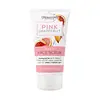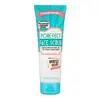What's inside
What's inside
 Key Ingredients
Key Ingredients

 Benefits
Benefits

 Concerns
Concerns

 Ingredients Side-by-side
Ingredients Side-by-side

Water
Skin ConditioningSodium Laureth Sulfate
CleansingCocamidopropyl Betaine
CleansingAcrylates/C10-30 Alkyl Acrylate Crosspolymer
Emulsion StabilisingOryza Sativa Germ Powder
AbrasivePolysorbate 20
EmulsifyingSodium Chloride
MaskingParfum
MaskingSodium Benzoate
MaskingSodium Cocoamphoacetate
CleansingPotassium Sorbate
PreservativeDisodium EDTA
Juglans Regia Shell Powder
AbrasiveSodium Hydroxide
BufferingGlycerin
HumectantTocopheryl Acetate
AntioxidantCitrus Paradisi Fruit Extract
Skin ConditioningPEG-18 Glyceryl Oleate/Cocoate
EmulsifyingCI 14700
Cosmetic ColorantCI 19140
Cosmetic ColorantWater, Sodium Laureth Sulfate, Cocamidopropyl Betaine, Acrylates/C10-30 Alkyl Acrylate Crosspolymer, Oryza Sativa Germ Powder, Polysorbate 20, Sodium Chloride, Parfum, Sodium Benzoate, Sodium Cocoamphoacetate, Potassium Sorbate, Disodium EDTA, Juglans Regia Shell Powder, Sodium Hydroxide, Glycerin, Tocopheryl Acetate, Citrus Paradisi Fruit Extract, PEG-18 Glyceryl Oleate/Cocoate, CI 14700, CI 19140
Water
Skin ConditioningAmmonium Lauryl Sulfate
CleansingAcrylates Copolymer
Pumice
AbrasiveCocamidopropyl Betaine
CleansingPolysorbate 20
EmulsifyingSodium Lauroyl Sarcosinate
CleansingBenzyl Alcohol
PerfumingParfum
MaskingGlycol Distearate
EmollientSodium Chloride
MaskingCoco-Glucoside
CleansingMenthol
MaskingStyrene/Acrylates Copolymer
Salicylic Acid
MaskingSodium Hydroxide
BufferingGlyceryl Oleate
EmollientGlyceryl Stearate
EmollientTriticum Vulgare Germ Oil
EmollientSodium Benzoate
MaskingGlycerin
HumectantCitric Acid
BufferingBenzyl Salicylate
PerfumingBenzoic Acid
MaskingPunica Granatum Extract
AstringentRubus Idaeus Fruit Extract
AstringentVaccinium Macrocarpon Fruit Extract
AstringentHydroxycitronellal
PerfumingHelianthus Annuus Seed Oil
EmollientSesamum Indicum Seed Oil
EmollientSorbic Acid
PreservativeAlpha-Isomethyl Ionone
PerfumingLimonene
PerfumingPotassium Sorbate
PreservativeCitral
PerfumingCoumarin
PerfumingEugenol
PerfumingLinalool
PerfumingTocopherol
AntioxidantCinnamal
PerfumingIsoeugenol
PerfumingBenzyl Benzoate
AntimicrobialCinnamyl Alcohol
PerfumingBenzyl Cinnamate
PerfumingCitronellol
PerfumingFarnesol
PerfumingGeraniol
PerfumingWater, Ammonium Lauryl Sulfate, Acrylates Copolymer, Pumice, Cocamidopropyl Betaine, Polysorbate 20, Sodium Lauroyl Sarcosinate, Benzyl Alcohol, Parfum, Glycol Distearate, Sodium Chloride, Coco-Glucoside, Menthol, Styrene/Acrylates Copolymer, Salicylic Acid, Sodium Hydroxide, Glyceryl Oleate, Glyceryl Stearate, Triticum Vulgare Germ Oil, Sodium Benzoate, Glycerin, Citric Acid, Benzyl Salicylate, Benzoic Acid, Punica Granatum Extract, Rubus Idaeus Fruit Extract, Vaccinium Macrocarpon Fruit Extract, Hydroxycitronellal, Helianthus Annuus Seed Oil, Sesamum Indicum Seed Oil, Sorbic Acid, Alpha-Isomethyl Ionone, Limonene, Potassium Sorbate, Citral, Coumarin, Eugenol, Linalool, Tocopherol, Cinnamal, Isoeugenol, Benzyl Benzoate, Cinnamyl Alcohol, Benzyl Cinnamate, Citronellol, Farnesol, Geraniol
Ingredients Explained
These ingredients are found in both products.
Ingredients higher up in an ingredient list are typically present in a larger amount.
Cocamidopropyl Betaine is a fatty acid created by mixing similar compounds in coconut oil and dimethylaminopropylamine, a compound with two amino groups.
This ingredient is a surfactant and cleanser. It helps gather the dirt, pollutants, and other impurities in your skin to be washed away. It also helps thicken a product and make the texture more creamy.
Being created from coconut oil means Cocamidopropyl Betaine is hydrating for the skin.
While Cocamidopropyl Betaine was believed to be an allergen, a study from 2012 disproved this. It found two compounds in unpure Cocamidopropyl Betaine to be the irritants: aminoamide and 3-dimethylaminopropylamine. High-grade and pure Cocamidopropyl Betaine did not induce allergic reactions during this study.
Learn more about Cocamidopropyl BetaineGlycerin is already naturally found in your skin. It helps moisturize and protect your skin.
A study from 2016 found glycerin to be more effective as a humectant than AHAs and hyaluronic acid.
As a humectant, it helps the skin stay hydrated by pulling moisture to your skin. The low molecular weight of glycerin allows it to pull moisture into the deeper layers of your skin.
Hydrated skin improves your skin barrier; Your skin barrier helps protect against irritants and bacteria.
Glycerin has also been found to have antimicrobial and antiviral properties. Due to these properties, glycerin is often used in wound and burn treatments.
In cosmetics, glycerin is usually derived from plants such as soybean or palm. However, it can also be sourced from animals, such as tallow or animal fat.
This ingredient is organic, colorless, odorless, and non-toxic.
Glycerin is the name for this ingredient in American English. British English uses Glycerol/Glycerine.
Learn more about GlycerinParfum is a catch-all term for an ingredient or more that is used to give a scent to products.
Also called "fragrance", this ingredient can be a blend of hundreds of chemicals or plant oils. This means every product with "fragrance" or "parfum" in the ingredients list is a different mixture.
For instance, Habanolide is a proprietary trade name for a specific aroma chemical. When used as a fragrance ingredient in cosmetics, most aroma chemicals fall under the broad labeling category of “FRAGRANCE” or “PARFUM” according to EU and US regulations.
The term 'parfum' or 'fragrance' is not regulated in many countries. In many cases, it is up to the brand to define this term.
For instance, many brands choose to label themselves as "fragrance-free" because they are not using synthetic fragrances. However, their products may still contain ingredients such as essential oils that are considered a fragrance by INCI standards.
One example is Calendula flower extract. Calendula is an essential oil that still imparts a scent or 'fragrance'.
Depending on the blend, the ingredients in the mixture can cause allergies and sensitivities on the skin. Some ingredients that are known EU allergens include linalool and citronellol.
Parfum can also be used to mask or cover an unpleasant scent.
The bottom line is: not all fragrances/parfum/ingredients are created equally. If you are worried about fragrances, we recommend taking a closer look at an ingredient. And of course, we always recommend speaking with a professional.
Learn more about ParfumPolysorbate 20 is made by combining ethoxylation of sorbitan, ethylene oxide, and lauric acid. It is a mild cleansing agent, surfactant, and emulsifier.
As a surfactant, it helps collect dirt and oils for washing. Emulsifiers prevent oils and water from separating.
Polysorbate 20 also adds scent to a product. Since it is made using sorbitol, it has a sweet scent. Sorbitol can also be found in fruits such as apples and peaches.
The lauric acid used to create Polysorbate 20 is often derived from coconuts.
Polysorbate 20 may not be fungal acne safe.
Learn more about Polysorbate 20Potassium Sorbate is a preservative used to prevent yeast and mold in products. It is commonly found in both cosmetic and food products.
This ingredient comes from potassium salt derived from sorbic acid. Sorbic acid is a natural antibiotic and effective against fungus.
Both potassium sorbate and sorbic acid can be found in baked goods, cheeses, dried meats, dried fruit, ice cream, pickles, wine, yogurt, and more.
You'll often find this ingredient used with other preservatives.
Learn more about Potassium SorbateSodium Benzoate is a preservative. It's used in both cosmetic and food products to inhibit the growth of mold and bacteria. It is typically produced synthetically.
Both the US FDA and EU Health Committee have approved the use of sodium benzoate. In the US, levels of 0.1% (of the total product) are allowed.
Sodium benzoate works as a preservative by inhibiting the growth of bacteria inside of cells. It prevents the cell from fermenting a type of sugar using an enzyme called phosphofructokinase.
It is the salt of benzoic acid. Foods containing sodium benzoate include soda, salad dressings, condiments, fruit juices, wines, and snack foods.
Studies for using ascorbic acid and sodium benzoate in cosmetics are lacking, especially in skincare routines with multiple steps.
We always recommend speaking with a professional, such as a dermatologist, if you have any concerns.
Learn more about Sodium BenzoateChances are, you eat sodium chloride every day. Sodium Chloride is also known as table salt.
This ingredient has many purposes in skincare: thickener, emulsifier, and exfoliator.
You'll most likely find this ingredient in cleansers where it is used to create a gel-like texture. As an emulsifier, it also prevents ingredients from separating.
There is much debate on whether this ingredient is comedogenic. The short answer - comedogenic ratings don't tell the whole story. Learn more about comegodenic ratings here.
The concensus about this ingredient causing acne seems to be divided. Research is needed to understand if this ingredient does cause acne.
Scrubs may use salt as the primary exfoliating ingredient.
Learn more about Sodium ChlorideSodium Hydroxide is also known as lye or caustic soda. It is used to adjust the pH of products; many ingredients require a specific pH to be effective.
In small amounts, sodium hydroxide is considered safe to use. However, large amounts may cause chemical burns due to its high alkaline.
Your skin has a natural pH and acid mantle. This acid mantle helps prevent harmful bacteria from breaking through. The acid mantle also helps keep your skin hydrated.
"Alkaline" refers to a high pH level. A low pH level would be considered acidic.
Learn more about Sodium HydroxideWater. It's the most common cosmetic ingredient of all. You'll usually see it at the top of ingredient lists, meaning that it makes up the largest part of the product.
So why is it so popular? Water most often acts as a solvent - this means that it helps dissolve other ingredients into the formulation.
You'll also recognize water as that liquid we all need to stay alive. If you see this, drink a glass of water. Stay hydrated!
Learn more about Water